2014 年 6 月英语四级真题(第三套)
Part I
Writing
(30 minutes)
Directions: Forthispart,youareallowed30minutestowriteashortessayonthe
followingquestion.Youshouldwriteatleast120wordsbutNomorethan
180 words.
Suppose a foreign friend of yours is coming to visit China, what is the first
place you would like to take him/her to see and why?
Part Ⅱ
Listening Comprehension
(30 minutes)
(说明:由于 2014 年 6 月六级考试全国共考了 2 套听力,本套真题听力与前 2 套内容完全
一样,只是顺序不一样,因此在本套真题中不再重复出现)
Part Ⅲ
Section A
Reading Comprehension
(40 minutes)
Directions: In this section, there isa passagewithten blanks.Youarerequired
toselectonewordforeachblankfromalistofchoicesgiveninaword
bank following the passage: Read the passage through carefully before
making yourchoices.Eachchoice inthebank isidentified bya letter.
PleasemarkthecorrespondingletterforeachitemonAnswerSheet2with
asinglelinethroughthecentre.Youmaynotuseanyofthewordsinthe
bank more than once.
Questions 36 to 45 are based on the following passage.
Global warming is a trend toward warmer conditions around the world. Part of
the warming is natural; we have experienced a 20,000-year-long warming as the last
ice age ended and the ice 36
away. However, we have already reached temperatures
that are in
37
with other minimum-ice periods, so continued warming is likely not
natural. We are
38
to a predicted worldwide increase in temperatures
39
between
1℃ and 6℃ over the next 100 years. The warming will be more
40
in some areas,
less in others, and some places may even cool off. Likewise, the
41
of this warming
will be very different depending on where you are-coastal areas must worry about
rising sea levels, while Siberia and northern Canada may become more habitable (益
居的) and
42
for humans than these areas are now.
�
The fact remains, however, that it will likely get warmer, on
43 , everywhere.
Scientists are in general agreement that the warmer conditions we have been
experiencing are at least in part the result of a human-induced global warming trend.
Some scientists
44
that the changes we are seeing fall within the range of random
(无规律的) variation—some years are cold, others warm, and we have just had an
unremarkable string of warm years
45
but that is becoming an increasingly rare
interpretation in the face of continued and increasing warm conditions.
A) appealing
B) average
C) contributing
D) dramatic
E) frequently
F) impact
G) line
H) maintain
Section B
I) melted
J) persist
K) ranging
L) recently
M) resolved
N) sensible
O) shock
Directions: In this section, you are going to read a passage with ten statements
attachedtoit.Eachstatementcontainsinformationgiveninoneofthe
paragraphs.Identifytheparagraphfromwhichtheinformationisderived.
Youmaychooseaparagraphmorethanonce.Eachparagraphismarkedwith
a letter. Answer the questions by marking the corresponding letter on
Answer Sheet 2.
The End of the Book?
[A] Amazon, by far the largest bookseller in the country, reported on May 19 that
it is now selling more books in its electronic Kindle format than in the old
paper-and-ink format. That is remarkable, considering that the Kindle has only
been around for four years. E-books now account for 14 percent of all book sales
in this country and are increasing far faster than overall book sales. E-book
sales are up 146 percent over last year, while hardback sales increased 6 percent
and paperbacks decreased 8 percent.
[B] Does this spell the doom of the physical book? Certainly not immediately, and
perhaps not at all. What it does mean is that the book business will go through
a transformation in the next decade or so more profound than any it has seen since
Gutenberg introduced printing from moveable type in the 1450s.
�
[C] Physical books will surely become much rarer in the marketplace. Mass market
paperbacks, which have been declining for years anyway, will probably disappear,
as will hardbacks for mysteries, thrillers, “romance fiction”, etc. Such books,
which only rarely end up in permanent collections, either private or public, will
probably only be available as e-books within a few years. Hardback and trade
paperbacks for “serious” nonfiction and fiction will surely last longer.
Perhaps it will become the mark of an author to reckon with that he or she is
still published in hard copy.
[D] As for children’s books, who knows? Children’s books are like dog food in that
the purchasers are not the consumers, so the market (and the marketing) is
inherently strange.
[E] For clues to the book’s future, let’s look at some examples of technological
change and see what happened to the old technology.
[F] One technology replaces another only because the new technology is better,
cheaper, or both. The greater the difference, the sooner and more thoroughly the
new technology replaces the old. Printing with moveable type on paper
dramatically reduced the cost of producing a book compared with the old-fashioned
ones handwritten on vellum, which comes from sheepskin. A Bible—to be sure, a
long book—required vellum made from 300 sheepskins and countless man-hours of
labor. Before printing arrived, a Bible cost more than a middle-class house. There
were perhaps 50,000 books in all of Europe in 1450. By 1500 there were 10 million.
[G] But while printing quickly caused the handwritten book to die out, handwriting
lingeredon(继续存在) well into the 16th century. Very special books are still
occasionally produced on vellum, but they are one-of-a-kind show pieces.
[H] Sometimes a new technology doesn’t drive the old one out, but only parts of
it while forcing the rest to evolve. The movies were widely predicted to drive
live theater out of the marketplace, but they didn’t, because theater turned
out to have qualities movies could not reproduce. Equally, TV was supposed to
replace movies but, again, did not.
[I] Movies did, however, fatally impact some parts of live theater. And while TV
didn’t kill movies, it did kill second-rate pictures, shorts, and cartoons.
�
[J] Nor did TV kill radio. Comedy and drama shows (“Jack Benny”, “Amos and Andy”
“The Shadow”) all migrated to television. But because you can’t drive a car
and watch television at the same time, rush hour became radio’s prime time, while
music, talk, and news radio greatly enlarged their audiences. Radio is today a
very different business than in the late 1940s and a much larger one.
[K] Sometimes old technology lingers for centuries because of its symbolic power.
Mountedcavalry(骑兵) replaced the chariot(二轮战车) on the battlefield around
1000 BC. But chariots maintained their place in parades and triumphs right up
until the end of the Roman Empire 1,500 years later. The sword hasn’t had a
military function for a hundred years, but is still part of an officer’s
full-dress uniform, precisely because a sword always symbolized “an officer
and a gentleman”.
[L] Sometimes new technology is a little cranky (不稳定的) at first. Television
repairman was a common occupation in the 1950s, for instance. And so the old
technology remains as a backup. Steamships captured the North Atlantic passenger
business from sail in the 1840s because of its much greater speed. But steamships
didn’t lose their sails until the 1880s, because early marine engines had a
nasty habit of breaking down. Until ships became large enough (and engines small
enough) to mount two engines side by side, they needed to keep sails. (The high
cost of steam and the lesser need for speed kept the majority of the world’s
ocean freight moving by sail until the early years of the 20th century.)
[M]
Then
there
is
the
fireplace.
Central
heating
was
present
in
upper-and-middle-class home by the second half of the 19th century. But
functioning fireplaces remain to this day a powerful selling point in a house
or apartment. I suspect the reason is a deep-rooted love of fire. Fire was one
of the earliest major technological advances for humankind, providing heat,
protection, and cooked food (which is much easier to eat and digest). Human
control of fire goes back far enough (over a million years) that evolution could
have produced a genetic leaning towards fire as a central aspect of human life.
[N] Books—especially books the average person could afford—haven’t been around
long enough to produce evolutionary change in humans. But they have a powerful
hold on many people nonetheless, a hold extending far beyond their literary
�
content. At their best, they are works of art and there is a tactile (触觉的)
pleasure in books necessarily lost in e-book versions. The ability to quickly
thumb through pages is also lost. And a room with books in it induces, at least
in some, a feeling not dissimilar to that of a fire in the fireplace on a cold
winter’s night.
[O] For these reasons I think physical books will have a longer existence as a
commercial product than some currently predict. Like swords, books have symbolic
power. Like fireplaces, they induce a sense of comfort and warmth. And, perhaps,
similar to sails, they make a useful backup for when the lights go out.
46. Authors still published in printed versions will be considered important ones.
47. Some people are still in favor of printed books because of the sense of touch
they can provide.
48. The radio business has changed greatly and now attracts more listeners.
49. Contrary to many people’s prediction of its death, the film industry survived.
50. Remarkable changes have taken place in the book business.
51. Old technology sometimes continues to exist because of its reliability.
52. The increase of e-book sales will force the book business to make changes not
seen for centuries.
53. A new technology is unlikely to take the place of an old one without a clear
advantage.
54. Paperbacks of popular literature are more likely to be replaced by e-books.
55. A house with a fireplace has a stronger appeal to buyers.
Section C
Directions: Thereare2passagesinthissection.Eachpassageisfollowedbysome
questions or unfinished statements. For each of them there are four
choicesmarkedA),B),C)andD).Youshoulddecideonthebestchoice
andmarkthecorrespondingletteronAnswerSheet2withasingleline
through the centre.
Passage One
Questions 56 to 60 are based on following passage.
The question of whether our government should promote science and technology
or the liberal arts in higher education isn’t an either/or proposition (命题),
�
although the current emphasis on preparing young Americans for STEM (science,
technology, engineering, maths) -related fields can make it seem that way.
The latest congressional report acknowledges the critical importance of
technical training, but also asserts that the study of the humanities (人文科学)
and social sciences must remain central components of America’s educational system
at all levels. Both areas are critical to producing citizens who can participate
effectively in our democratic society, become innovative (创新的) leaders, and
benefit from the spiritual enrichment that the reflection on the great ideas of
mankind over time provides.
Parents and students who have invested heavily in higher education worry about
graduates’ job prospects as technological advances and changes in domestic and
global markets transform professions in ways that reduce wages and cut jobs. Under
these circumstances, it’s natural to look for what may appear to be the most
“practical” way out of the problem: “Major in a subject designed to get you a
job” seems the obvious answer to some, though this ignores the fact that many
disciplines in the humanities characterized as “soft” often, in fact, lead to
employment and success in the long run. Indeed, according to surveys, employers have
expressed a preference for students who have received a broadly-based education that
has taught them to write well, think critically, research creatively, and
communicate easily.
Moreover, students should be prepared not just for their first job, but for
their 4th and 5th jobs, as there’s little reason to doubt that people entering the
workforce today will be called upon to play many different roles over the course
of their careers. The ones who will do the best in this new environment will be those
whose educations have prepared them to be flexible. The ability to draw upon every
available tool and insight—picked up from science, arts, and technology—to solve
the problems of the future, and take advantage of the opportunities that present
themselves, will be helpful to them and the United States.
56. What does the latest congressional report suggest?
A. STEM-related subjects help students find jobs in the information society.
B. The humanities and STEM subjects should be given equal importance.
C. The liberal arts in higher education help enrich students’ spiritual life.
D. Higher education should be adjusted to the practical needs of society.
57. What is the main concern of students when they choose a major?
A. Their interest in relevant subjects.
B. The academic value of the courses.
�
C. The quality of education to receive.
D. Their chances of getting a good job.
58. What does the author say about the so-called soft subjects?
A. They benefit students in their future life.
B. They broaden students’ range of interests.
C. They improve students’ communication skills.
D. They are essential to students’ healthy growth.
59. What kind of job applicants do employers look for?
A. Those who have a strong sense of responsibility.
B. Those who are good at solving practical problems.
C. Those who are likely to become innovative leaders.
D. Those who have received a well-rounded education.
60. What advice does the author give to college students?
A. Seize opportunities to tap their potential.
B. Try to take a variety of practical courses.
C. Prepare themselves for different job options.
D. Adopt a flexible approach to solving problems.
Passage Two
Questions 61 to 65 are based on the following passage.
Energy independence. It has a nice ring to it, doesn’t it? If you think so,
you’re not alone, because energy independence has been the dream of American
presidents for decades, and never more so than in the past few years, when the most
recent oil price shock has been partly responsible for kicking off the great
recession.
“Energy independence” and its rhetorical ( 修 辞 的 ) companion “energy
security” are, however, slippery concepts that are rarely thought through. What
is it we want independence from, exactly?
Most people would probably say that they want to be independent from imported
oil. But there are reasons that we buy all that off from elsewhere.
The first reason is that we need it to keep our economy running. Yes, there
is a trickle (涓涓细流) of biofuel (生物燃料) available, and more may become
available, but most biofueis cause economic waste and environmental destruction.
Second, Americans have basically decided that they don’t really want to
produce all their own oil. They value the environmental quality they preserve, over
their off imports from abroad. Vast areas of the United States are off-limits to
off exploration and production in the name of environmental protection. To what
�
extent are Americans really willing to endure the environmental impacts of domestic
energy production in order to cut back imports?
Third, there are benefits to trade. It allows for economic efficiency, and when
we buy things from places that have lower production costs than we do, we benefit.
And although you don’t read about this much, the United States is also a large
exporter of off products, selling about 2 million barrels of petroleum products per
day to about 90 countries.
There is no question that the United States imports a great deal of energy and,
in fact, relies on that steady flow to maintain its economy. When that flow is
interrupted, we feel the pain in short supplies and higher prices. At the same time,
we derive massive economic benefits when we buy the most affordable energy on the
world market and when we engage in energy trade around the world.
61. What does the author say about energy independence for America?
A. It sounds very attractive.
B. It ensures national security.
C. It will bring oil prices down.
D. It has long been everyone’s dream.
62. What does the author think of biofuels?
A. They keep America’s economy running healthily.
B. They prove to be a good alternative to petroleum.
C. They do not provide a sustainable energy supply.
D. They cause serious damage to the environment.
63. Why does America rely heavily on off imports?
A. It wants to expand its storage of crude oil.
B. Its own oil reserves are quickly running out.
C. It wants to keep its own environment intact.
D. Its own oil production falls short of demand.
64. What does the author say about oil trade?
A. It proves profitable to both sides.
B. It improves economic efficiency.
C. It makes for economic prosperity.
D. It saves the cost of oil exploration.
65. What is the author’s purpose in writing the passage?
A. To justify America’s dependence on oil imports.
B. To arouse Americans’ awareness of the energy crisis.
C. To stress the importance of energy conservation.
D. To explain the increase of international oil trade.
�
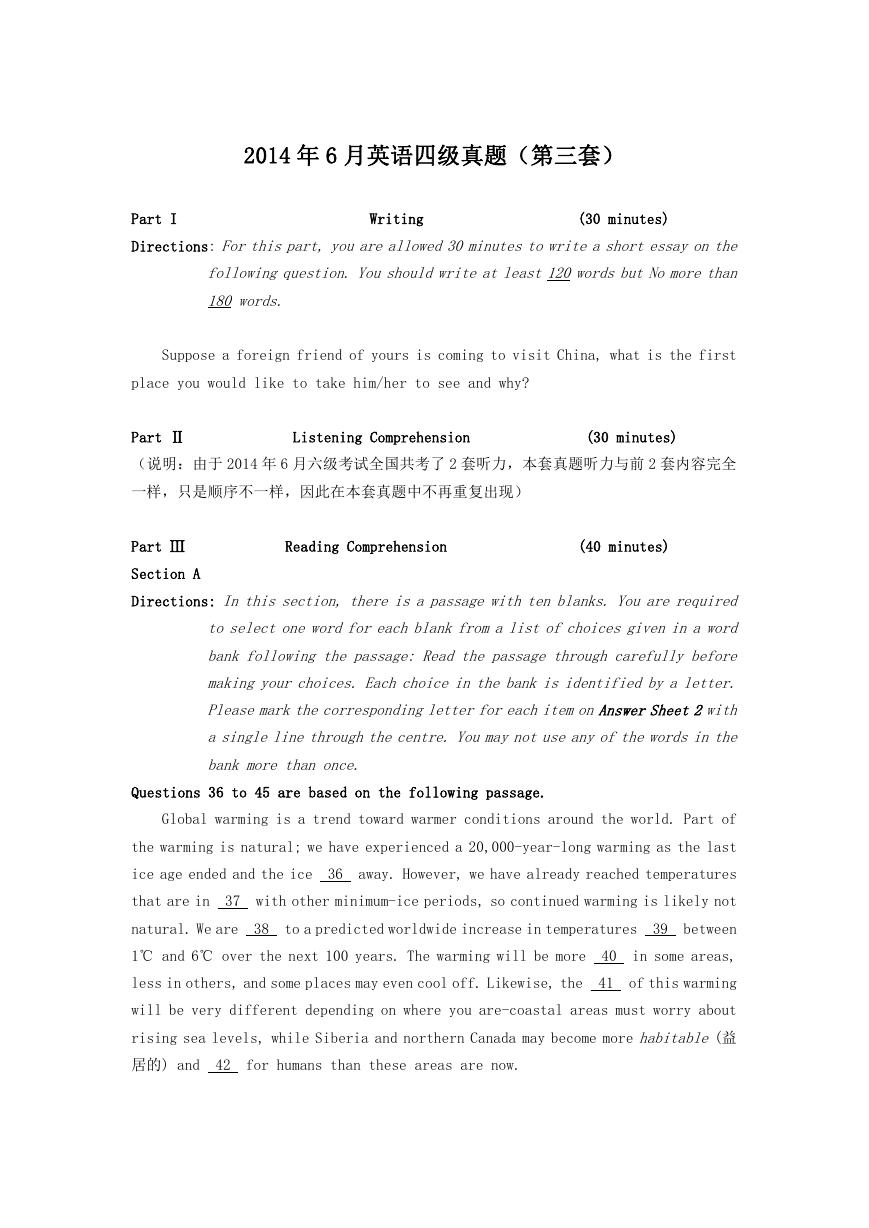
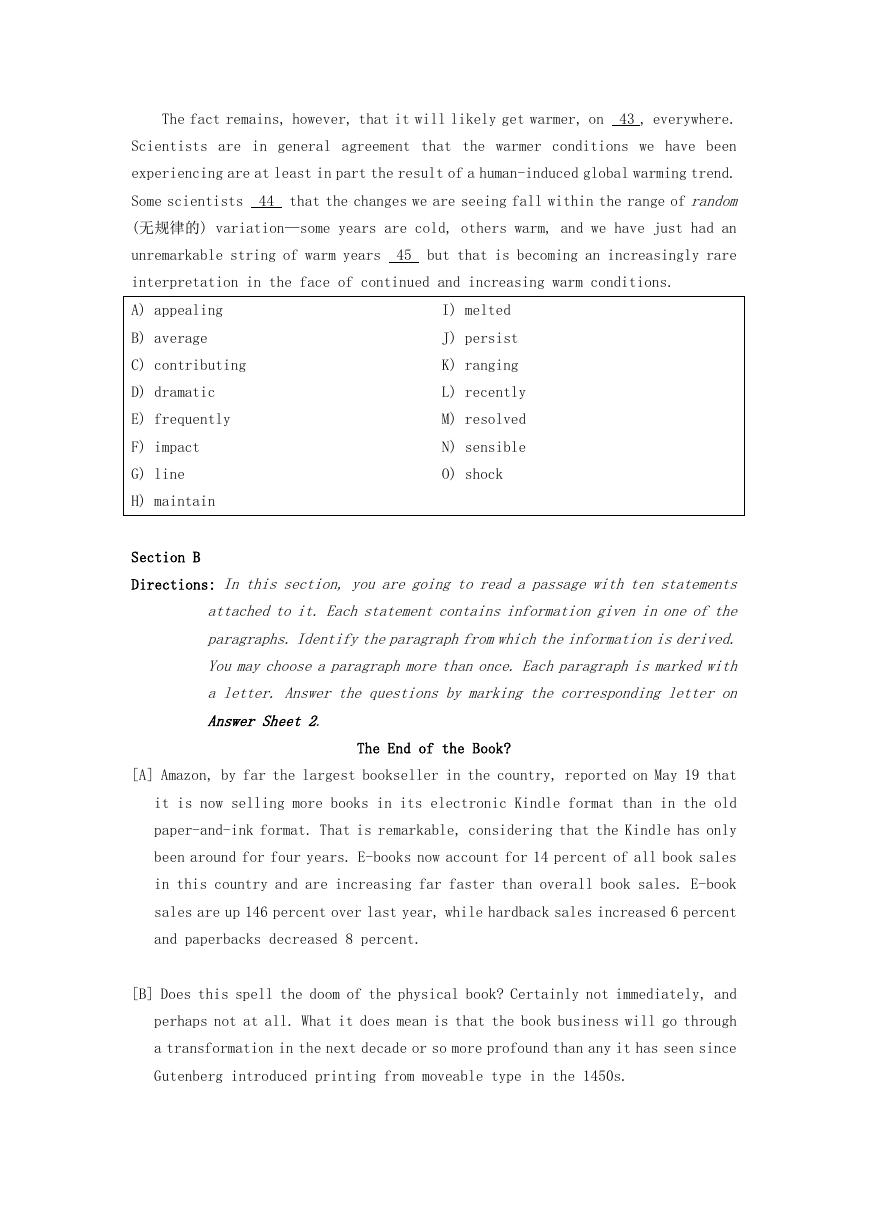

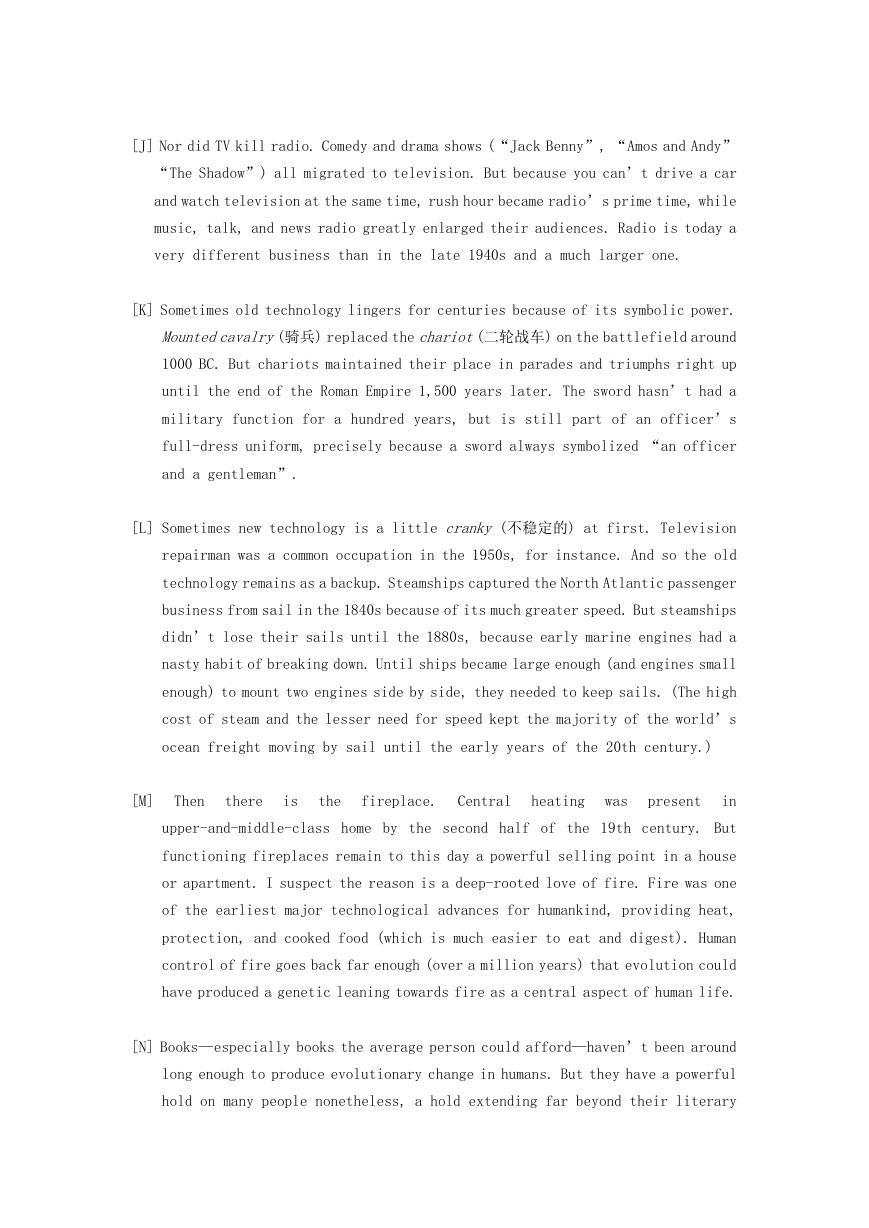
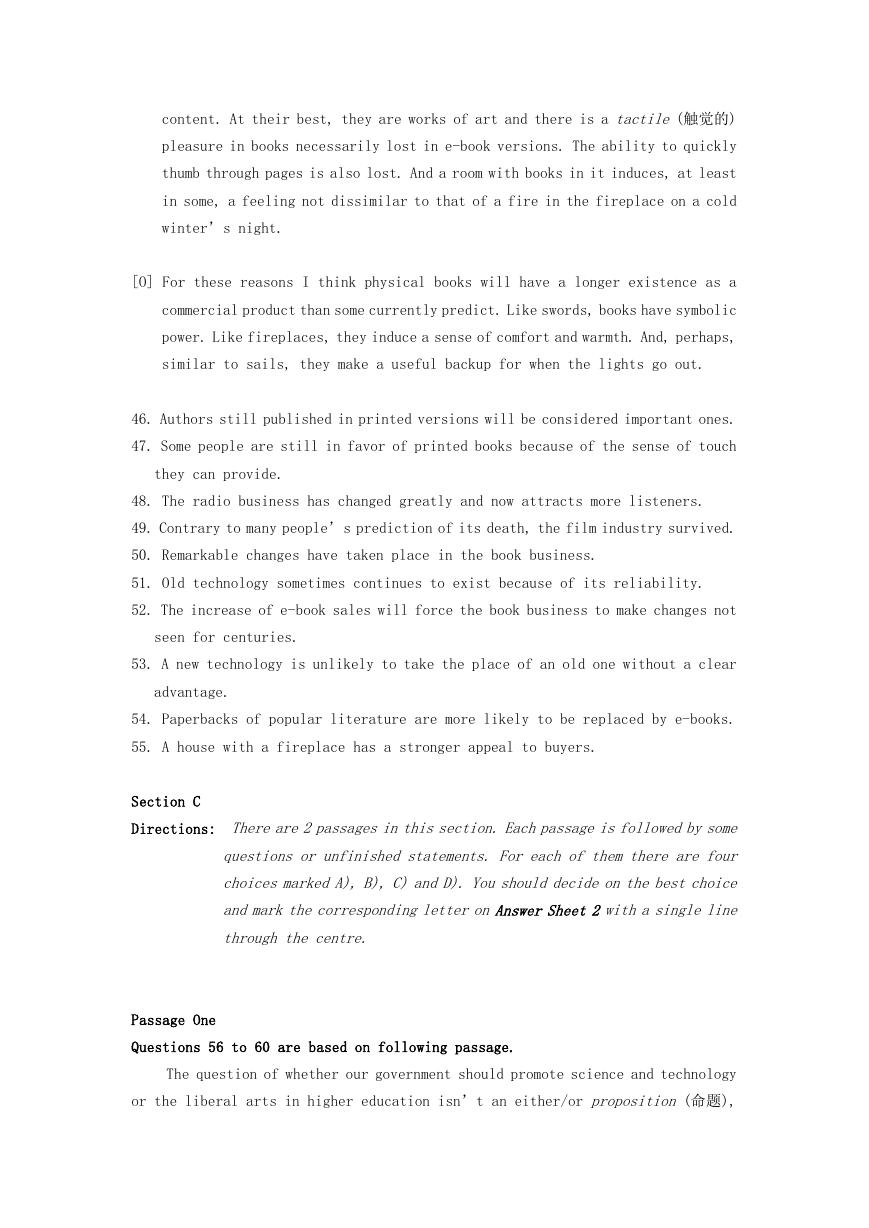

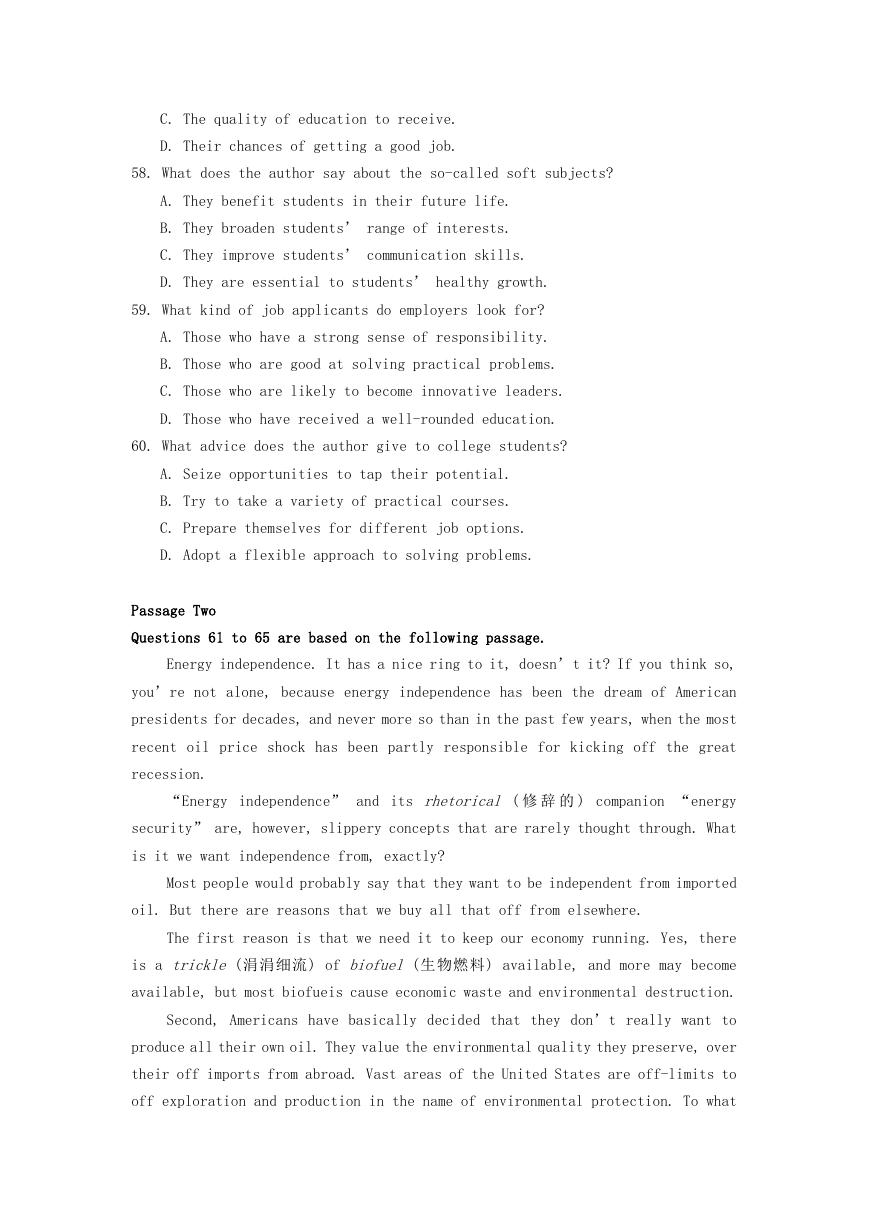
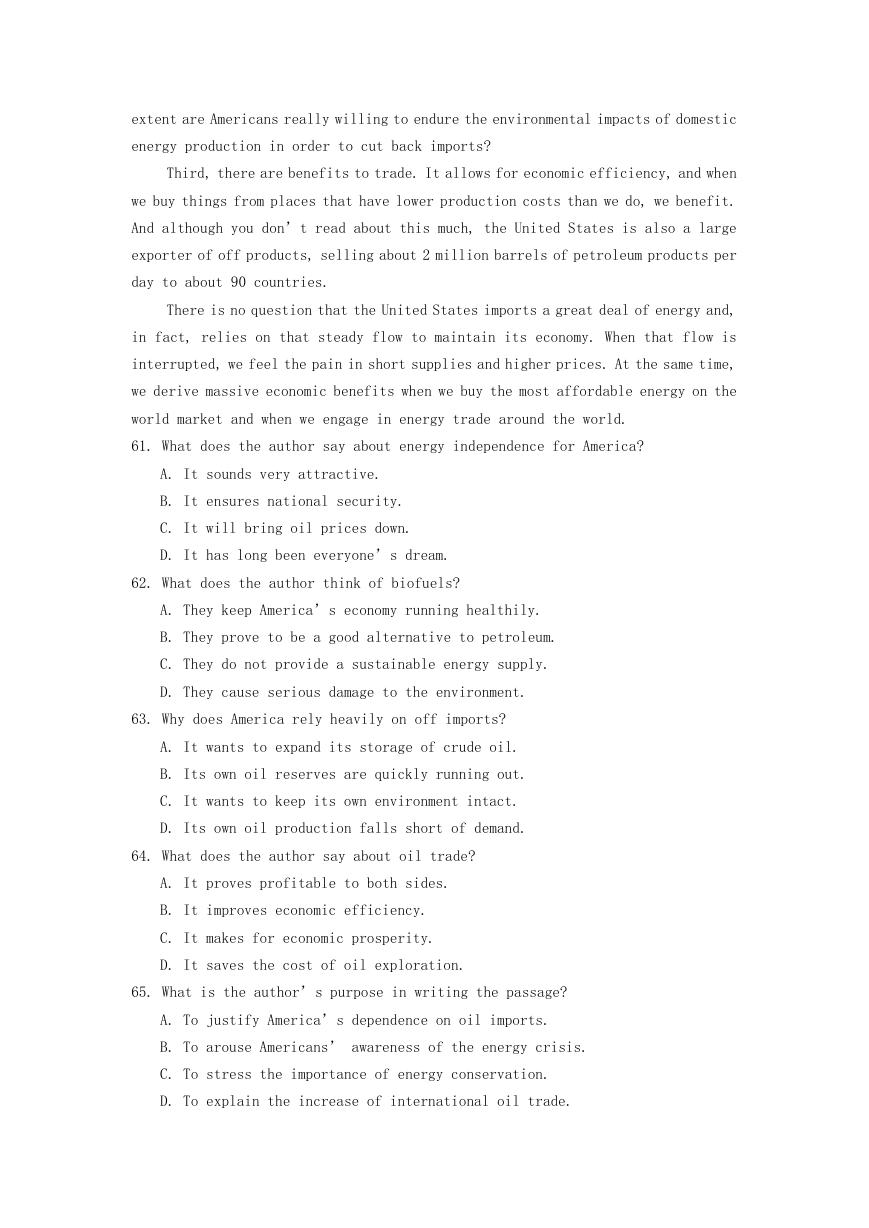








 2023年江西萍乡中考道德与法治真题及答案.doc
2023年江西萍乡中考道德与法治真题及答案.doc 2012年重庆南川中考生物真题及答案.doc
2012年重庆南川中考生物真题及答案.doc 2013年江西师范大学地理学综合及文艺理论基础考研真题.doc
2013年江西师范大学地理学综合及文艺理论基础考研真题.doc 2020年四川甘孜小升初语文真题及答案I卷.doc
2020年四川甘孜小升初语文真题及答案I卷.doc 2020年注册岩土工程师专业基础考试真题及答案.doc
2020年注册岩土工程师专业基础考试真题及答案.doc 2023-2024学年福建省厦门市九年级上学期数学月考试题及答案.doc
2023-2024学年福建省厦门市九年级上学期数学月考试题及答案.doc 2021-2022学年辽宁省沈阳市大东区九年级上学期语文期末试题及答案.doc
2021-2022学年辽宁省沈阳市大东区九年级上学期语文期末试题及答案.doc 2022-2023学年北京东城区初三第一学期物理期末试卷及答案.doc
2022-2023学年北京东城区初三第一学期物理期末试卷及答案.doc 2018上半年江西教师资格初中地理学科知识与教学能力真题及答案.doc
2018上半年江西教师资格初中地理学科知识与教学能力真题及答案.doc 2012年河北国家公务员申论考试真题及答案-省级.doc
2012年河北国家公务员申论考试真题及答案-省级.doc 2020-2021学年江苏省扬州市江都区邵樊片九年级上学期数学第一次质量检测试题及答案.doc
2020-2021学年江苏省扬州市江都区邵樊片九年级上学期数学第一次质量检测试题及答案.doc 2022下半年黑龙江教师资格证中学综合素质真题及答案.doc
2022下半年黑龙江教师资格证中学综合素质真题及答案.doc